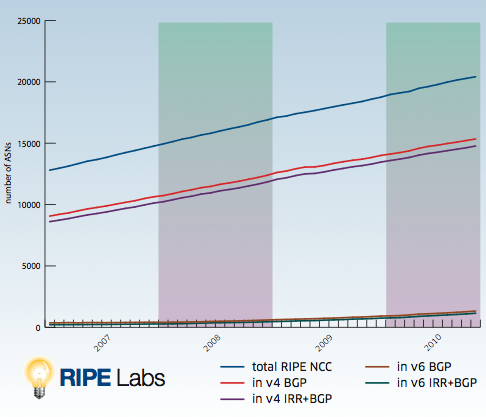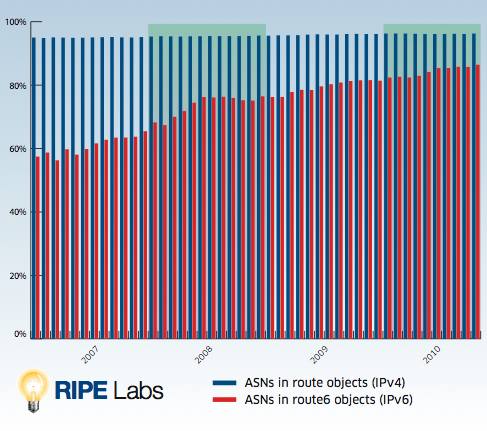It is often claimed that the Internet Routing Registry is not accurate and complete enough. Is this really the case? In this article we are looking at how many organisations that receive an Autonomous System Number from the RIPE NCC use the RIPE Routing Registry.
Introduction
The Internet Routing Registry (IRR) is a globally distributed routing information database. The IRR consists of several databases run by various organisations in which network operators can publish their routing policies and their routing announcements such that other network operators can make use of the data. In addition to making Internet topology visible, the IRR is used by network operators to look up peering agreements, determine optimal policies, and more recently, to configure their routers.
It is often claimed that the IRR is not used enough, is not complete and not up to date and is therefore not a reliable source for routing information. And because the IRR is spread over multiple databases, some pars of it might be more complete and up to date than others.
The RIPE NCC is also maintaining a Routing Registry (RR) as part of the RIPE Database. It is considered good practice to register routing policy in a routing registry. Having routing policy registered in the RR, makes it easier for network operators to configure and manage their routers. Some Internet service providers even require their customer’s routes to be registered in the RR before agreeing to route these address prefixes. We were interested to find out how many of those organisations that receive an Autonomous System Number (ASN) from the RIPE NCC use the RIPE RR.
Methodology
In order to find that out, we checked which AS numbers assigned by RIPE NCC also originate an IPv4 or IPv6 address prefix in BGP (more specifically in the BGP data seen in the Routing Information Service (RIS) ). We then looked at the RIPE routing registry to see how many of those ASNs are listed as origin AS in a route object or a route6 object respectively.
Results
Figure 1 shows the evolution of:
- the total number of RIPE NCC administered ASNs (blue)
- the total number of RIPE NCC ASNs seen as origin AS in RIS IPv4 routes (red)
- the total number of RIPE NCC ASNs seen as origin AS in RIS IPv4 routes and listed in (one or more) RIPE RR route objects (purple)
- the total number of RIPE NCC ASNs seen as origin AS in RIS IPv6 routes (brown)
- the total number of RIPE NCC ASNs seen as origin AS in RIS IPv6 routes and listed in (one or more) RIPE RR route6 object (green)

This shows that, although the percentage of RIPE NCC assigned ASNs seen in RIS is only some 70-75%, almost all of these ASNs appear as origin AS in at least one route object in the RIPE Routing Registry.
In Figure 2 we see how many of those ASNs that were assigned by the RIPE NCC and that originate a route object (either for an IPv4 or an IPv6 prefix) in the RIS, are also listed as origin AS in a route or route6 object in the RIPE Routing Registry.

For IPv4 route objects (blue) the percentage is very high and stable for the last few years, around 95%. That means almost all organisations that receive an ASN from the RIPE NCC and that originate a route in BGP also register a route object in the RIPE Routing Registry. Even without knowing how accurate and up-to-date these objects are, the fact that such a large fraction is registered is a great sign.
For route6 objects (red) the numbers are a little lower: 86% of ASNs that originate IPv6 routes in the routing system, is also registered in the RIPE Routing Registry. In 2007 this number was only 60%, and it has been steadily increasing over time.
Future Research
Now we know that a high percentage of ASNs register their route objects in the RIPE Routing Registry, it would be interesting to find how accurate and up to date that information is. Does the routing policy in the RR reflect real routing as observed in BGP? Watch this space.
Acknowledgments
This article is based on work done by Rene Wilhelm, Emile Aben and Paul Palse.






Comments 3
The comments section is closed for articles published more than a year ago. If you'd like to inform us of any issues, please contact us.
Anonymous •
...when researchers and operators repeat the mantra that "it is well known that the data in routing registries is incomplete and outdated to the point of being useless."<br /><br />I'd be interested in how the other 5%/14% (unregistered but in BGP) routes are composed. I suspect that there are some geographical sub-regions where registration is "more optional" than in others. But maybe there are other effects in play as well - for example, more specifics that are useful for traffic engineering but not essential for reachability, so people don't bother registering them (maybe they are somewhat ashamed of their traffic engineering).<br /><br />The fact that IPv4 has better registry fidelity than IPv6 surprised me. Probably there are still a few ISPs who do a bit of IPv6 but don't take it seriously to the point of registering the routes - the excuse being that "our highly automated tools don't support IPv6", I guess.
Anonymous •
Hi Simon,<br /><br />Thanks for your interest. In this article we only looked at AS numbers. We were interested to see how many of those who originate a prefix in BGP made the effort to register a route, any route, in the RIPE RR. The fact that this percentage is so high and stable over the years for RIPE NCC assigned ASNs is encouraging. The next step is to compare the actual routes registered in the RR with what is announced in BGP, including cases of aggregates vs. more specifics. That is all work in progress on which we will report soon. <br /><br />Rene
Anonymous •
I would like to see how other RIRs compare to RIPE. I would bet that the RIPE RR is far more accurate than other at other RIRs.